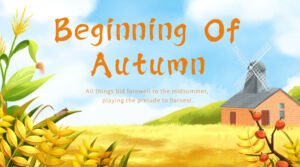
Permulaan Musim Luruh adalah salah satu daripada 24 istilah solar di China, antara 7 atau 8 Ogos dalam kalendar Gregory setiap tahun. Ia adalah penghujung musim panas dan permulaan musim luruh. Asal usul aktiviti musim luruh adalah berkaitan dengan geografi, iklim, dan aktiviti pertanian.
Permulaan musim luruh terdiri daripada dua watak: berdiri dan musim luruh. Li merujuk kepada permulaan, dan musim luruh merujuk kepada musim luruh. Maksud permulaan musim luruh merujuk kepada kemasukan rasmi musim luruh pada masa ini.
Nama dan tempoh istilah solar liqiu ditentukan berdasarkan kenaikan astronomi kuno dan perubahan iklim geografi. Orang dahulu menilai perubahan bermusim dengan memerhatikan trajektori matahari dan putaran bumi. Pada hari awal musim luruh, Apabila matahari mencapai bujur 135 °, kedudukan matahari secara langsung bersinar di bumi bergerak ke bujur 135 °.
Sementara itu, Dengan kedatangan permulaan musim luruh, Percutian musim panas secara beransur -ansur terganggu dan memasuki musim luruh yang sejuk. Petani biasanya mula menuai beberapa tanaman musim panas selepas permulaan musim luruh dan memulakan aktiviti pertanian pada musim luruh, seperti menuai dan menyimpan tanaman, Bersedia untuk menanam tanaman musim luruh, dan lain-lain.
Permulaan musim luruh juga dianggap sebagai perayaan tradisional, di mana orang mengadakan upacara pengorbanan untuk mengucapkan terima kasih atas musim panas dan berdoa untuk menuai musim luruh yang berlimpah dan keadaan cuaca yang menguntungkan.
Walaupun pertanian moden tidak lagi bergantung pada istilah suria untuk mengatur aktiviti pertanian seperti pada zaman dahulu, permulaan musim luruh, Sebagai salah satu istilah suria Cina tradisional, masih mengekalkan kepentingan tertentu dan merupakan komponen penting dalam budaya pertanian kuno Cina.
Keseluruhannya, Permulaan musim luruh adalah istilah suria yang penting. Akhir musim panas dan permulaan musim luruh mempunyai kepentingan astronomi dan geografi, serta kepentingan budaya pertanian dan tradisional. Ia mewakili hasil panen yang berlimpah dan menghargai dan berdoa alam semula jadi.


